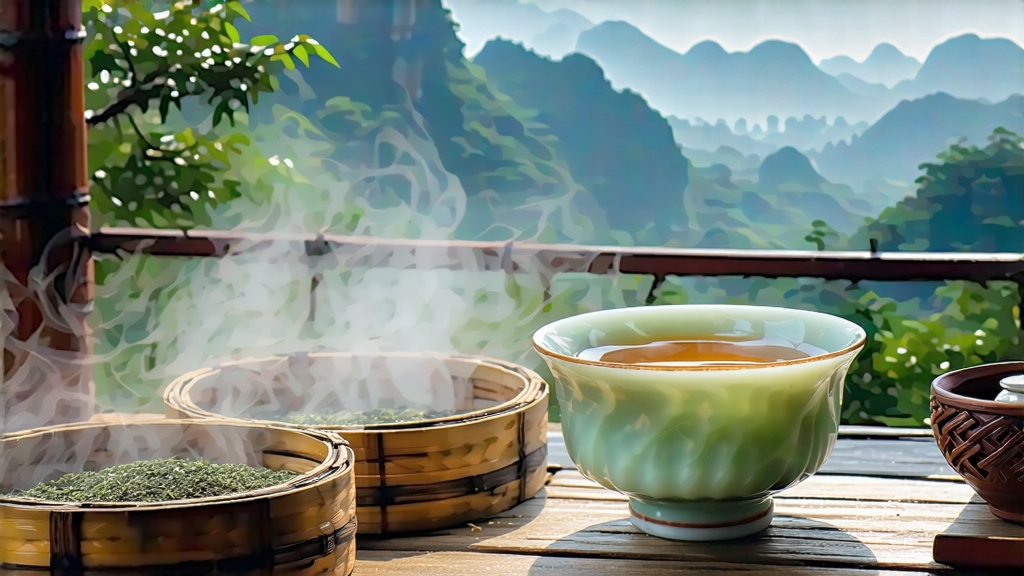
Liu Bao cha—literally “Six Forts tea”—owes its name to the six ancient stockade villages that once guarded the trade pass linking Guangxi’s Wuzhou county to the Pearl River delta. Caravans of mules and coolies carried the tea through humid karst gorges, believing that the farther the leaves traveled the deeper their flavor would become. What began as a pragmatic way to keep tea mold-free during the 36-day march to Guangzhou’s Thirteen Factories evolved, over four centuries, into one of China’s most soulful dark teas: a drink that tastes of camphor forests, cellars, and the slow passage of time.
Unlike the better-known Pu-erh of Yunnan, Liu Bao never courted imperial favor; it rode the bottom of cargo boats bound for Southeast Asia, pressed into coarse baskets lined with bamboo skin and banana leaf. In Kuala Lumpur’s tin-mining camps and Penang’s opium dens it became the working man’s balm—strong, cheap, and rumored to cool the blood after a night of gambling. The British, busy auctioning Assam and Ceylon, barely noticed the sacks quietly off-loaded at Singapore’s Clifford Pier. Thus Liu Bao remained a diaspora secret until the 2006 renaissance of Chinese dark teas sent collectors scrambling to the damp warehouses of Hong Kong and Kuching, where 30-year-old baskets still exuded the scent of rain-soaked camphor wood.
The tea belongs to the hei cha family, yet its micro-flora is distinct. Yunnan’s Pu-erh relies on Aspergillus niger and Blastobotrys adeninivorans; Liu Bao is dominated by Candida tropicalis and a novel yeast recently named Wickerhamomyces anomalus wuzhouensis. These microbes thrive on the unique “wet-pile” recipe of Guangxi: 85 % humidity, 55 °C internal heap temperature, and repeated sprinklings of the local Yu River water whose mineral load is high in iron and manganese. The result is a tea that darkens faster, yet retains a surprising clarity in the cup—an ebony liquor rimmed with marigold halos.
Raw material is plucked from the Da Ye cultivar, a large-leaf ancestor of Camellia sinensis var. assamica that migrated south during the Song. Farmers pick one bud with three or four leaves in the last week of April, when the monsoon’s first thunder is said to “wake the roots.” The leaves are carried in bamboo sieves down the mountain before sunset; any delay risks the unwanted bloom of Penicillium that would stamp the tea with a sour, cardboard note. Withering is brief—two hours under banana-leaf shade—then a 300 °C tumble in iron woks just long enough to rupture 30 % of the cell walls. What follows is a curious twist: instead of immediate rolling, the leaves are piled 30 cm high and covered with wet jute sacks for “sweating.” During this 90-minute rest the leaf temperature climbs to 40 °C, activating polyphenol oxidase and triggering a pre-fermentation that softens grassiness into dried-longan sweetness.
Rolling is done by foot—literally. An experienced master steps barefoot onto the bamboo tray, shifting weight from heel to toe in a slow dance that coils the leaves into tight twists without breaking the veins. The foot’s warmth helps maintain enzymatic activity, while the arch acts as a natural spring that evens pressure across the tray. After a thirty-minute rest the leaves are sun-dried for exactly one day; any longer and Guangxi’s fierce UV would flatten aromatics. The semi-finished mao cha is now ready for the defining step: wet piling.
A traditional Liu Bao factory resembles a terraced rice field turned indoors. Concrete bays, each 3 m wide and 12 m long, are lined with banana-trunk mats. Workers sprinkle 80 kg of mao cha with 12 L of river water, then rake the heap into a loaf 70 cm high. The pile is left untouched for 24 hours, during which the core temperature rises to 48 °C and a faint aroma of cooked rice wafts out. On day two the heap is turned by pitchfork, sprayed again, and covered with jute. This cycle repeats seven times over 35 days, the pile shrinking by half as